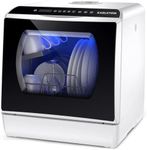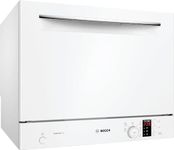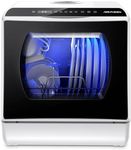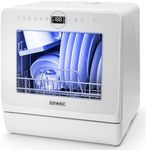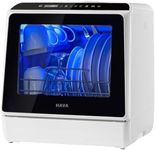Buying Guide for the Best Countertop Dishwashers
Choosing the right countertop dishwasher can make your kitchen chores much easier and more efficient. Countertop dishwashers are compact, portable, and perfect for small kitchens or apartments where space is limited. When selecting a countertop dishwasher, it's important to consider several key specifications to ensure you get the best fit for your needs. Understanding these specs will help you make an informed decision and find a model that suits your lifestyle and dishwashing requirements.Size and CapacitySize and capacity refer to the physical dimensions of the dishwasher and how many dishes it can hold. This is important because you need to ensure the dishwasher fits on your countertop and can handle the volume of dishes you typically use. Sizes can vary, but most countertop dishwashers are designed to fit under standard kitchen cabinets. Capacity is often measured in place settings, with a typical range being 4 to 6 place settings. If you have a small household or don't generate many dirty dishes, a smaller capacity may suffice. For larger households or frequent entertainers, a higher capacity might be necessary.
Water ConsumptionWater consumption indicates how much water the dishwasher uses per cycle. This is important for both environmental and cost reasons. Lower water consumption is generally better as it saves water and reduces utility bills. Countertop dishwashers typically use between 2 to 4 gallons of water per cycle. If you are environmentally conscious or want to save on water bills, look for models with lower water consumption. However, ensure that the lower water usage does not compromise the cleaning performance.
Energy EfficiencyEnergy efficiency measures how much electricity the dishwasher uses. This is important for reducing your energy bills and minimizing your environmental footprint. Energy-efficient models are often labeled with an Energy Star rating. Countertop dishwashers with higher energy efficiency will use less electricity per cycle. If you are looking to save on energy costs and reduce your environmental impact, choose a model with a high energy efficiency rating.
Noise LevelNoise level refers to how loud the dishwasher is during operation, measured in decibels (dB). This is important if you have an open-plan kitchen or if you run the dishwasher at night. Lower decibel levels mean quieter operation. Countertop dishwashers typically range from 45 to 60 dB. If you prefer a quieter environment, look for models with lower noise levels. However, keep in mind that quieter models may come at a higher price.
Wash Cycles and OptionsWash cycles and options refer to the different settings and programs the dishwasher offers for cleaning dishes. This is important for flexibility and ensuring your dishes are cleaned properly. Common cycles include normal, heavy, light, and eco modes. Some models also offer specialized cycles like glass or baby care. If you have a variety of dishwashing needs, look for a model with multiple wash cycles and options. This will allow you to customize the wash according to the type and dirtiness of your dishes.
Ease of Installation and UseEase of installation and use refers to how simple it is to set up and operate the dishwasher. This is important for convenience and ensuring you can start using the appliance without hassle. Most countertop dishwashers are designed to be easy to install, often requiring just a connection to a faucet and a power outlet. Look for models with clear instructions and user-friendly controls. If you are not very handy or prefer a straightforward setup, choose a model known for its ease of installation and intuitive operation.
Drying PerformanceDrying performance indicates how well the dishwasher dries the dishes after washing. This is important to avoid having to hand-dry dishes after a cycle. Some models use heated drying, while others rely on air drying. Heated drying is generally more effective but can use more energy. If you want your dishes to come out completely dry and ready to use, look for models with good drying performance. Consider whether you prioritize energy efficiency or convenience when choosing the drying method.
